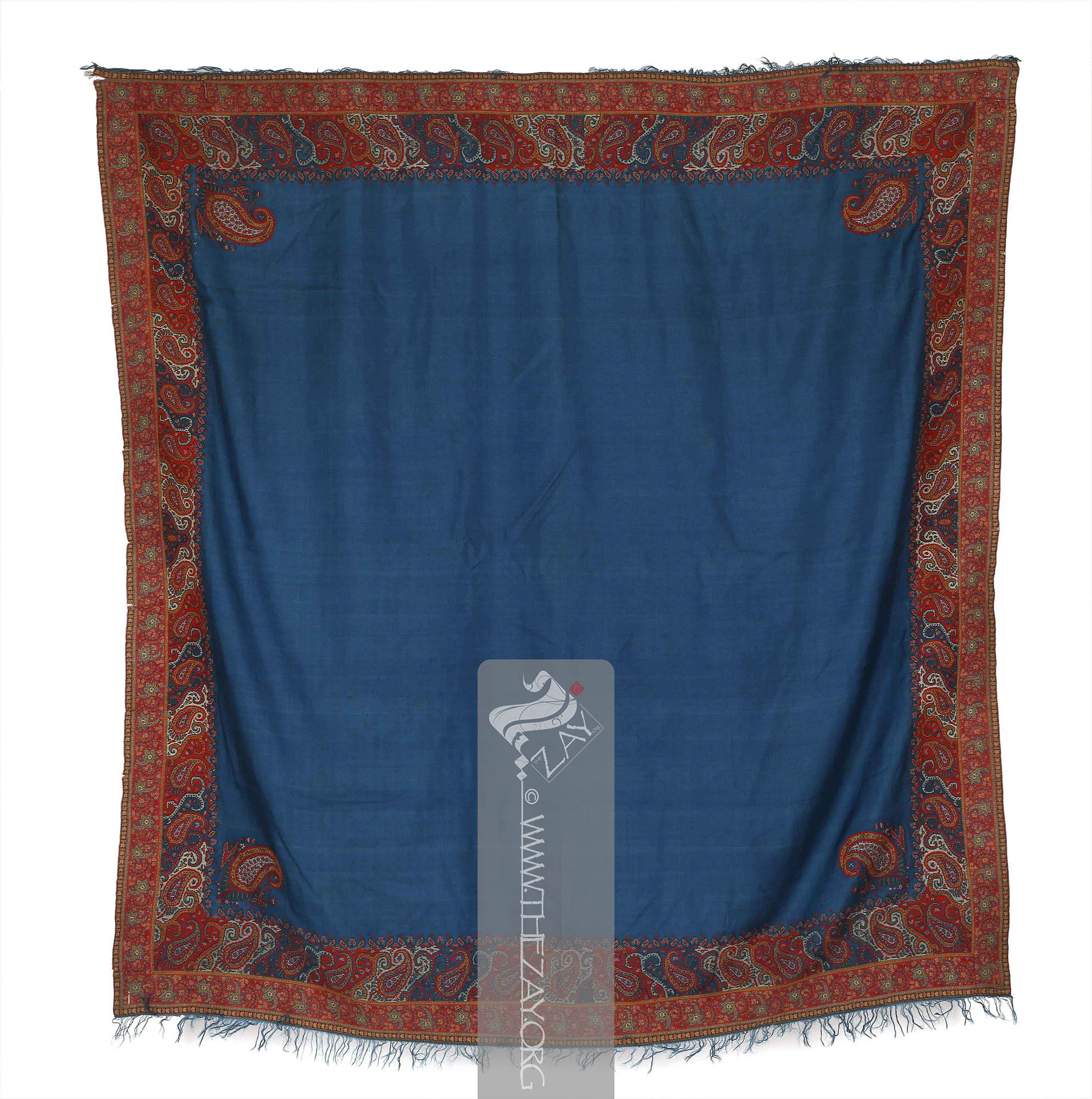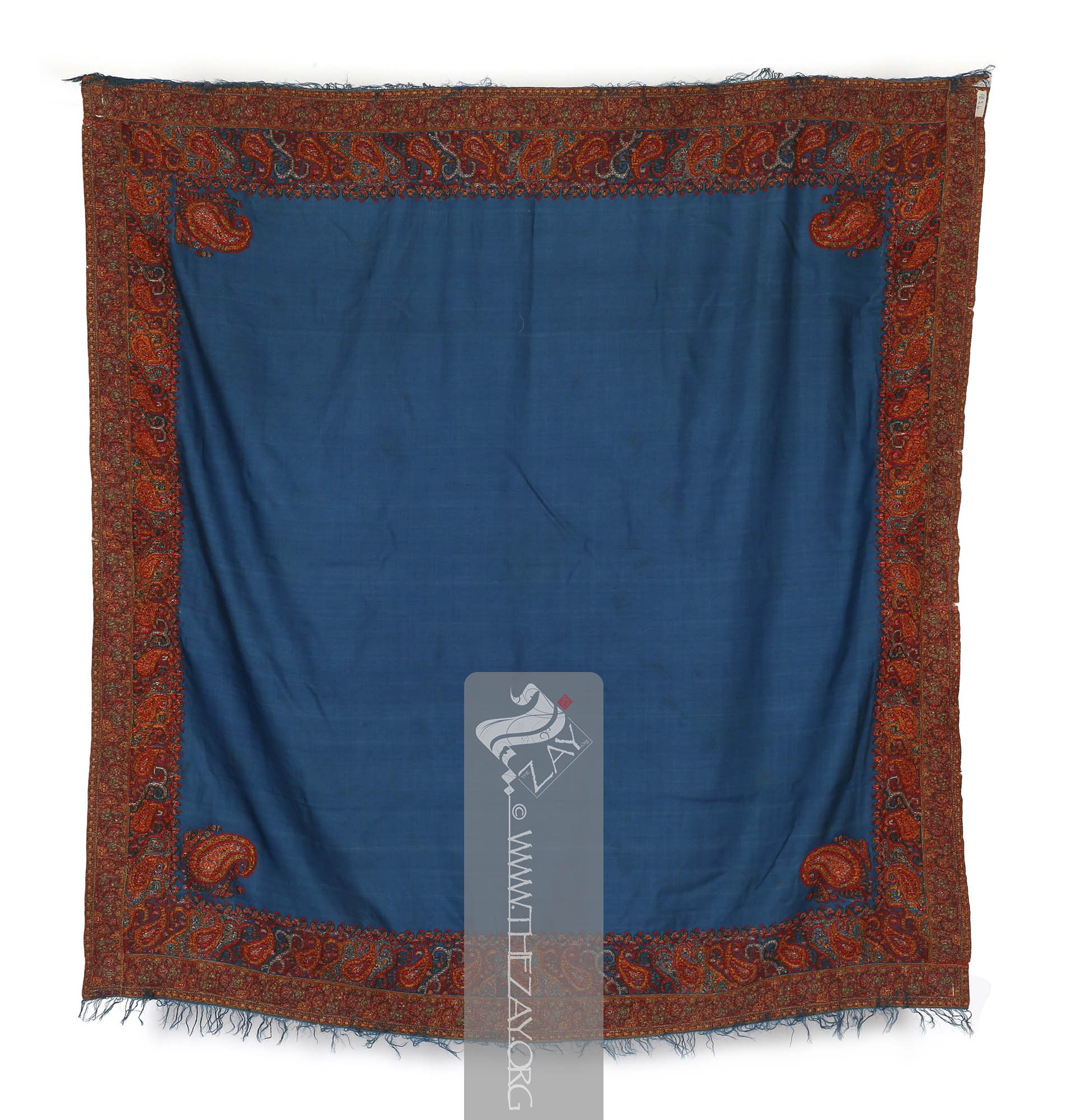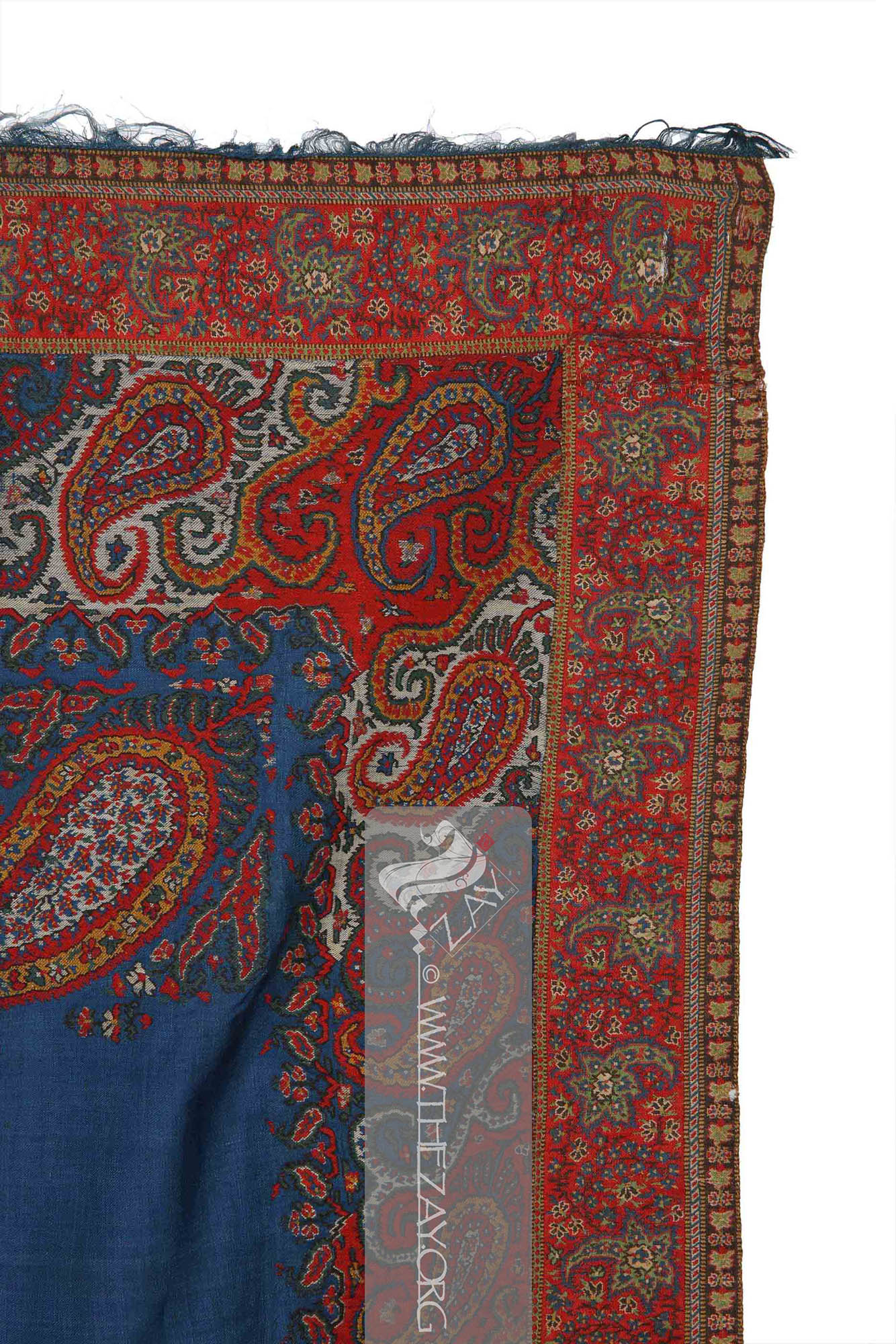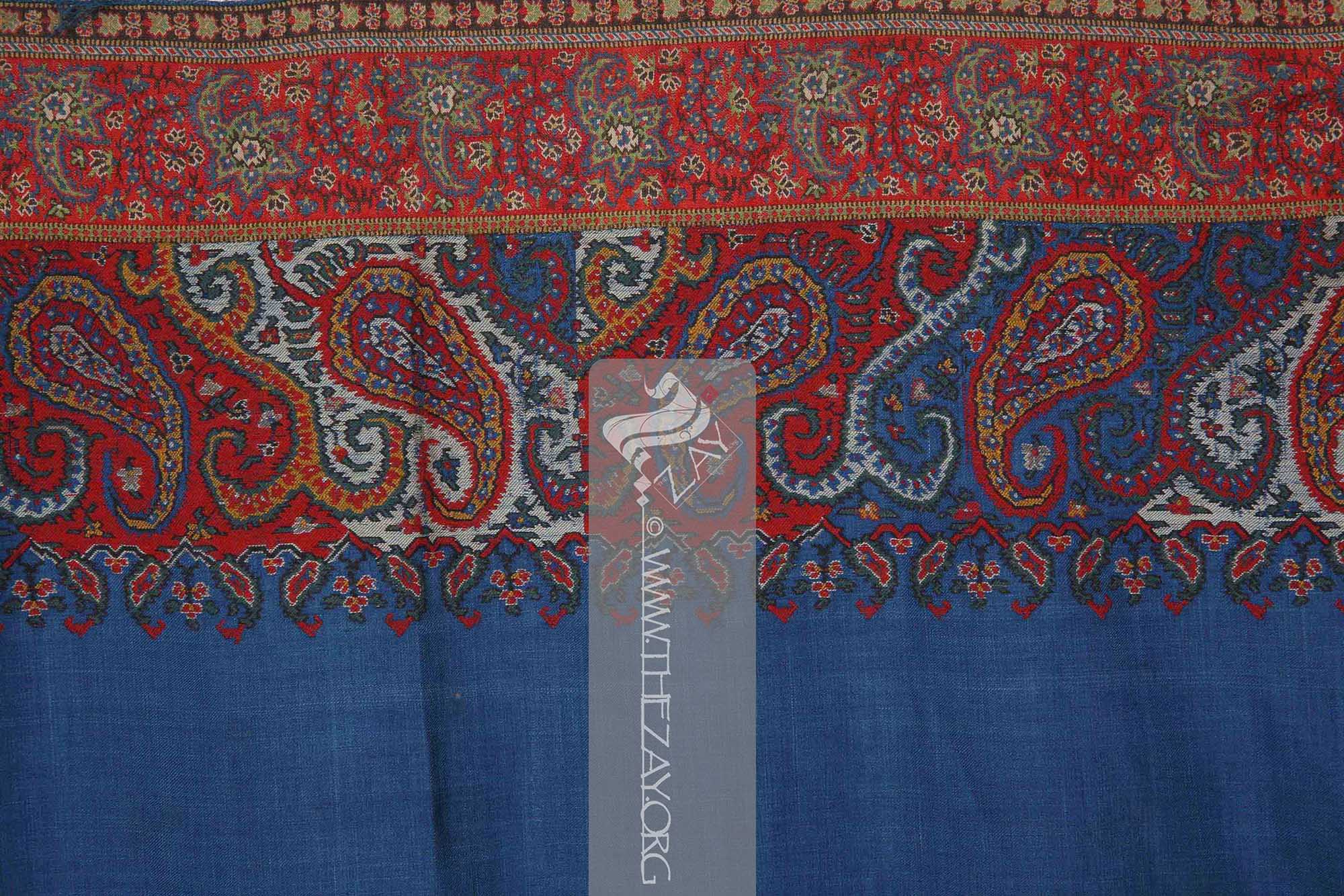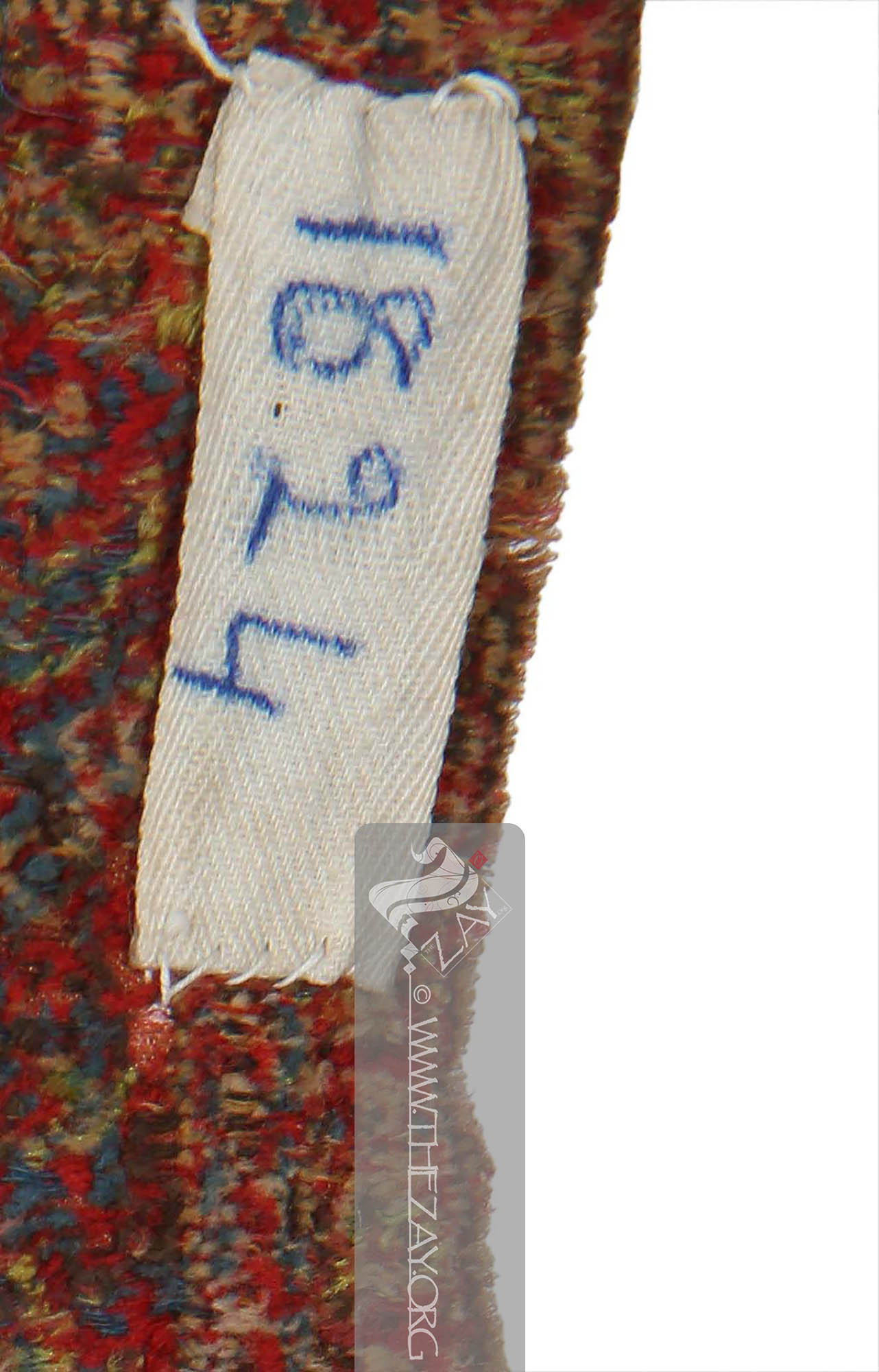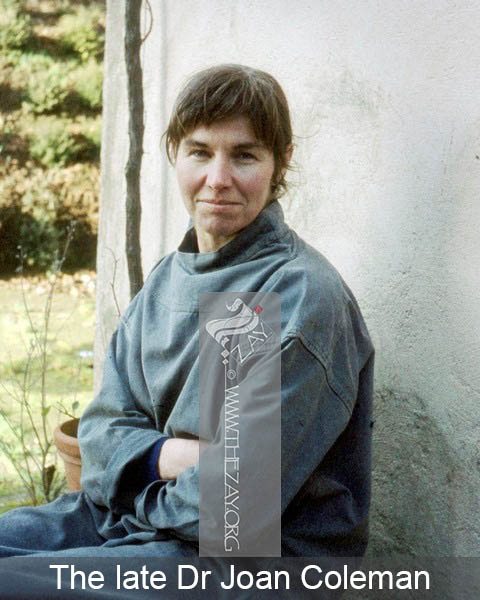Object NotePart of a set of two along with (ZI2021.500952.1 EUROPE). Object HistoryThis blue silk (shawl
Shawl: (Persian: shāl from Hindi: duśālā – Shoulder Mantle), a shawl is a South Asian version of a scarf worn or wrapped loosely over the shoulders and is usually made of wool. ) dating back to the first quarter of the 19th century was originally a part of the Dr Joan Coleman Collection. It was part of a duo of shawls along with (ZI2021.500952.1 EUROPE). Zay
Zay: (Arabic: costume, Pl. azyaā’), a set of clothes in a style typical of a particular country or historical period. Initiative managed to acquire it from Kerry Taylor Auctions in 2021. Dr Joan Coleman began collecting shawls in 1976 and developed her lifelong passion for collecting. She was a regular at the London salesrooms of Christie’s, Sotheby’s, and Phillips – three of the most outstanding auction houses of the period in the world – getting to know the dealers and learning in the process. She acquired vast knowledge and dedicated hours carefully cataloguing her ever-growing collection. She intended to loan her collection to different museums and institutions for the benefit of learning and education. Her collection is one of the largest and the finest private shawl
Shawl: (Persian: shāl from Hindi: duśālā – Shoulder Mantle), a shawl is a South Asian version of a scarf worn or wrapped loosely over the shoulders and is usually made of wool. collections ever graced the world with shawls ranging from Kashmir, Paisley
Paisley: (Scottish Gaelic, Pàislig: a town in Scotland), often called buta, boteh, amli, or kalgi in the subcontinent and kazuwah in Arabic, is a Persian tear drop motif with a curved end specially in textiles. Its popularity and subsequent local production in 18th century at Paisley are responsible for its nomenclature., Edinburgh, Norwich, France, and Iran. Object Features This is a woven rectangular silk
shawl
Shawl: (Persian: shāl from Hindi: duśālā – Shoulder Mantle), a shawl is a South Asian version of a scarf worn or wrapped loosely over the shoulders and is usually made of wool. with a royal blue base and polychromatic woollen embellishment. Probably woven in
Paisley
Paisley: (Scottish Gaelic, Pàislig: a town in Scotland), often called buta, boteh, amli, or kalgi in the subcontinent and kazuwah in Arabic, is a Persian tear drop motif with a curved end specially in textiles. Its popularity and subsequent local production in 18th century at Paisley are responsible for its nomenclature. c. 1825 -1835, this
shawl
Shawl: (Persian: shāl from Hindi: duśālā – Shoulder Mantle), a shawl is a South Asian version of a scarf worn or wrapped loosely over the shoulders and is usually made of wool. originated in a (
draw_loom
Draw_loom: (English) It is a type of weaving apparatus that enables complex patterns to be woven into textiles. It uses a system of cords and pulleys to control the warp
Warp: One of the two basic components used in weaving which transforms thread or yarns to a piece of fabric. The warp is the set of yarns stretched longitudinally in place on a loom before the weft
Weft: one of the two basic components used in weaving that transforms thread or yarns into a piece of fabric. It is the crosswise thread on a loom that is passed over and under the warp threads. is introduced during the weaving process. threads, allowing individual threads to be lifted and lowered to create intricate designs.).
The
shawl
Shawl: (Persian: shāl from Hindi: duśālā – Shoulder Mantle), a shawl is a South Asian version of a scarf worn or wrapped loosely over the shoulders and is usually made of wool. has four tiers of the frame forming a thick border with an empty central field or body except the four tilted (
kunjbuta
Kunjbuta: (Sanskrit: kunj – place or corner associated with greenery; and Sanskrit: buta – foliage motif), the word is probably a portmanteau of two Sanskrit words it usually refers to the corner ornaments or decoration on a shawl
Shawl: (Persian: shāl from Hindi: duśālā – Shoulder Mantle), a shawl is a South Asian version of a scarf worn or wrapped loosely over the shoulders and is usually made of wool. . )/(
paisley
Paisley: (Scottish Gaelic, Pàislig: a town in Scotland), often called buta, boteh, amli, or kalgi in the subcontinent and kazuwah in Arabic, is a Persian tear drop motif with a curved end specially in textiles. Its popularity and subsequent local production in 18th century at Paisley are responsible for its nomenclature.) in a hedge of foliage at the corners. The outermost tier along the edge of the
shawl
Shawl: (Persian: shāl from Hindi: duśālā – Shoulder Mantle), a shawl is a South Asian version of a scarf worn or wrapped loosely over the shoulders and is usually made of wool. consists of a line of floral repeats in scarlet red and beige. The second tier is a (
jaal
Jaal: (Sanskrit: jaal – A net, web, or a mesh), the decoration which fills the ground between the paisley
Paisley: (Scottish Gaelic, Pàislig: a town in Scotland), often called buta, boteh, amli, or kalgi in the subcontinent and kazuwah in Arabic, is a Persian tear drop motif with a curved end specially in textiles. Its popularity and subsequent local production in 18th century at Paisley are responsible for its nomenclature. cones at the heads of a shawl
Shawl: (Persian: shāl from Hindi: duśālā – Shoulder Mantle), a shawl is a South Asian version of a scarf worn or wrapped loosely over the shoulders and is usually made of wool. .
) of dense floral arrangements mostly in scarlet, blue and green, with a star-shaped floral motif repeated in alternate orientation at regular intervals.
The third tier is the thickest of the lot and consists of a row of
paisley
Paisley: (Scottish Gaelic, Pàislig: a town in Scotland), often called buta, boteh, amli, or kalgi in the subcontinent and kazuwah in Arabic, is a Persian tear drop motif with a curved end specially in textiles. Its popularity and subsequent local production in 18th century at Paisley are responsible for its nomenclature./(
buta
Būta: (Anglicized Persian: boteh – Pinecone shaped motif), known as paisley
Paisley: (Scottish Gaelic, Pàislig: a town in Scotland), often called buta, boteh, amli, or kalgi in the subcontinent and kazuwah in Arabic, is a Persian tear drop motif with a curved end specially in textiles. Its popularity and subsequent local production in 18th century at Paisley are responsible for its nomenclature. in English it is the almond or pinecone-shaped motif, especially in textiles. It is believed to have originated from the Cyprus tree a Zoroastrian symbol for life and eternity. In the current Indian context, however, it simply means motif.) with stylized curved and thick vines for a
jaal
Jaal: (Sanskrit: jaal – A net, web, or a mesh), the decoration which fills the ground between the paisley
Paisley: (Scottish Gaelic, Pàislig: a town in Scotland), often called buta, boteh, amli, or kalgi in the subcontinent and kazuwah in Arabic, is a Persian tear drop motif with a curved end specially in textiles. Its popularity and subsequent local production in 18th century at Paisley are responsible for its nomenclature. cones at the heads of a shawl
Shawl: (Persian: shāl from Hindi: duśālā – Shoulder Mantle), a shawl is a South Asian version of a scarf worn or wrapped loosely over the shoulders and is usually made of wool. .
between them. This entire arrangement is in a myriad of colours – scarlet, blue, green, and yellow with ivory highlights. The final tier is composed of two sprigs of foliage with a flower in between repeating itself in a row. Both the floral and foliage motifs are woven in scarlet with beige highlights while the branches are woven in green.
The
kunjbuta
Kunjbuta: (Sanskrit: kunj – place or corner associated with greenery; and Sanskrit: buta – foliage motif), the word is probably a portmanteau of two Sanskrit words it usually refers to the corner ornaments or decoration on a shawl
Shawl: (Persian: shāl from Hindi: duśālā – Shoulder Mantle), a shawl is a South Asian version of a scarf worn or wrapped loosely over the shoulders and is usually made of wool. . are resting on a (
pai
Pai: (Hindustani: pai – Straight line or base line) The foot or pediment of a buta or a paisley
Paisley: (Scottish Gaelic, Pàislig: a town in Scotland), often called buta, boteh, amli, or kalgi in the subcontinent and kazuwah in Arabic, is a Persian tear drop motif with a curved end specially in textiles. Its popularity and subsequent local production in 18th century at Paisley are responsible for its nomenclature. motif. ) mostly composed of foliage in green with sprigs of flowers on either side woven in scarlet and ivory. Each
paisley
Paisley: (Scottish Gaelic, Pàislig: a town in Scotland), often called buta, boteh, amli, or kalgi in the subcontinent and kazuwah in Arabic, is a Persian tear drop motif with a curved end specially in textiles. Its popularity and subsequent local production in 18th century at Paisley are responsible for its nomenclature. motif itself is composed of four different layers of floral arrangements in different colours. The first and the third layers consist of scarlet flowers and encase a yellow layer in between themselves. The final layer forming the (
shikam
Shikam: (Persian: shikam or shikm – Belly or stomach), the belly of a buta or a paisley motif. ) of each
paisley
Paisley: (Scottish Gaelic, Pàislig: a town in Scotland), often called buta, boteh, amli, or kalgi in the subcontinent and kazuwah in Arabic, is a Persian tear drop motif with a curved end specially in textiles. Its popularity and subsequent local production in 18th century at Paisley are responsible for its nomenclature. is composed of blue and scarlet flowers on an ivory bed.
The borders of the
shawl
Shawl: (Persian: shāl from Hindi: duśālā – Shoulder Mantle), a shawl is a South Asian version of a scarf worn or wrapped loosely over the shoulders and is usually made of wool. have been separately woven before attaching them to the main body by means of a machine stitch. They are of the same dimensions all around, however, the (
warp
Warp: One of the two basic components used in weaving which transforms thread or yarns to a piece of fabric. The warp is the set of yarns stretched longitudinally in place on a loom before the weft
Weft: one of the two basic components used in weaving that transforms thread or yarns into a piece of fabric. It is the crosswise thread on a loom that is passed over and under the warp threads. is introduced during the weaving process. ) ends of the
shawl
Shawl: (Persian: shāl from Hindi: duśālā – Shoulder Mantle), a shawl is a South Asian version of a scarf worn or wrapped loosely over the shoulders and is usually made of wool. have a strip of the base fabric with loose hanging threads forming a series of fringes attached to the borders, thus giving this
shawl
Shawl: (Persian: shāl from Hindi: duśālā – Shoulder Mantle), a shawl is a South Asian version of a scarf worn or wrapped loosely over the shoulders and is usually made of wool. its final touch.
Links
- Irwin, John. The Kashmir Shawls. Her Majesty's Stationary Office, 1981.
- Thornton, Zita. "The Norwich Shawl
Shawl: (Persian: shāl from Hindi: duśālā – Shoulder Mantle), a shawl is a South Asian version of a scarf worn or wrapped loosely over the shoulders and is usually made of wool. ." Antiques Info, vol. 4, 2001, http://www.antiques-info.co.uk/new/pdf/Mar01/4.pdf
- Skarratt, Ben. "From India to Europe: The Production of the Kashmir Shawl
Shawl: (Persian: shāl from Hindi: duśālā – Shoulder Mantle), a shawl is a South Asian version of a scarf worn or wrapped loosely over the shoulders and is usually made of wool. and the Spread of the Paisley
Paisley: (Scottish Gaelic, Pàislig: a town in Scotland), often called buta, boteh, amli, or kalgi in the subcontinent and kazuwah in Arabic, is a Persian tear drop motif with a curved end specially in textiles. Its popularity and subsequent local production in 18th century at Paisley are responsible for its nomenclature. Motif." Global History of Capitalism, University of Oxford, 2018, https://globalcapitalism.history.ox.ac.uk/sites/default/files/globalcapitalism/documents/media/case_04_-_the_paisley_0.pdf
- Sethi, Ritu. Handmade for the 21st Century: Safeguarding Traditional Indian Textiles. UNESCO, 2022.
- Quaile, Sheilagh Dr. "Cashmere
Cashmere: (Anglisized from Hindustani: Kashmir – A region or province in the Indian subcontinent), a fine soft natural wool, from the hair of goats native to the Kashmir, Ladakh and neighbouring regions of the Indian subcontinent. Often confused with Pashmina
Pāshmīna: (Persian: pašm or pashm – wool), pashmina scarves are eponymous woolen shawls from the Kashmir region with a history dating back to more than 500 years. It is the finest variant of spun cashmere wool extracted from the downy undercoat of the Changthangi goats found in the Ladakh province. , it should be noted that all cashmeres are not pashmina
Pāshmīna: (Persian: pašm or pashm – wool), pashmina scarves are eponymous woolen shawls from the Kashmir region with a history dating back to more than 500 years. It is the finest variant of spun cashmere wool extracted from the downy undercoat of the Changthangi goats found in the Ladakh province. . Shawls." Khan Academy, www.khanacademy.org/humanities/art-asia/south-asia/x97ec695a:1500-1850-deccan-south/a/cashmere
Cashmere: (Anglisized from Hindustani: Kashmir – A region or province in the Indian subcontinent), a fine soft natural wool, from the hair of goats native to the Kashmir, Ladakh and neighbouring regions of the Indian subcontinent. Often confused with Pashmina
Pāshmīna: (Persian: pašm or pashm – wool), pashmina scarves are eponymous woolen shawls from the Kashmir region with a history dating back to more than 500 years. It is the finest variant of spun cashmere wool extracted from the downy undercoat of the Changthangi goats found in the Ladakh province. , it should be noted that all cashmeres are not pashmina
Pāshmīna: (Persian: pašm or pashm – wool), pashmina scarves are eponymous woolen shawls from the Kashmir region with a history dating back to more than 500 years. It is the finest variant of spun cashmere wool extracted from the downy undercoat of the Changthangi goats found in the Ladakh province. . -shawls
- Van Schoor, Jennifer Ann (2019) The Indian cashmere
Cashmere: (Anglisized from Hindustani: Kashmir – A region or province in the Indian subcontinent), a fine soft natural wool, from the hair of goats native to the Kashmir, Ladakh and neighbouring regions of the Indian subcontinent. Often confused with Pashmina
Pāshmīna: (Persian: pašm or pashm – wool), pashmina scarves are eponymous woolen shawls from the Kashmir region with a history dating back to more than 500 years. It is the finest variant of spun cashmere wool extracted from the downy undercoat of the Changthangi goats found in the Ladakh province. , it should be noted that all cashmeres are not pashmina
Pāshmīna: (Persian: pašm or pashm – wool), pashmina scarves are eponymous woolen shawls from the Kashmir region with a history dating back to more than 500 years. It is the finest variant of spun cashmere wool extracted from the downy undercoat of the Changthangi goats found in the Ladakh province. . shawl
Shawl: (Persian: shāl from Hindi: duśālā – Shoulder Mantle), a shawl is a South Asian version of a scarf worn or wrapped loosely over the shoulders and is usually made of wool. and social status in British art, 1760-1870. [Thesis] (Unpublished) https://eprints.bbk.ac.uk/id/eprint/40406/1/VAN%20SCHOOR%20J.A.%20–%20PHD%202019-vol%201.pdf
- Andrew Newey, “Cashmere
Cashmere: (Anglisized from Hindustani: Kashmir – A region or province in the Indian subcontinent), a fine soft natural wool, from the hair of goats native to the Kashmir, Ladakh and neighbouring regions of the Indian subcontinent. Often confused with Pashmina
Pāshmīna: (Persian: pašm or pashm – wool), pashmina scarves are eponymous woolen shawls from the Kashmir region with a history dating back to more than 500 years. It is the finest variant of spun cashmere wool extracted from the downy undercoat of the Changthangi goats found in the Ladakh province. , it should be noted that all cashmeres are not pashmina
Pāshmīna: (Persian: pašm or pashm – wool), pashmina scarves are eponymous woolen shawls from the Kashmir region with a history dating back to more than 500 years. It is the finest variant of spun cashmere wool extracted from the downy undercoat of the Changthangi goats found in the Ladakh province. . Country: The Perils of Making the World’s Finest Fabric,” The Guardian (10 January 2020), https://www.theguardian.com/environment/2020/jan/10/cashmere
Cashmere: (Anglisized from Hindustani: Kashmir – A region or province in the Indian subcontinent), a fine soft natural wool, from the hair of goats native to the Kashmir, Ladakh and neighbouring regions of the Indian subcontinent. Often confused with Pashmina
Pāshmīna: (Persian: pašm or pashm – wool), pashmina scarves are eponymous woolen shawls from the Kashmir region with a history dating back to more than 500 years. It is the finest variant of spun cashmere wool extracted from the downy undercoat of the Changthangi goats found in the Ladakh province. , it should be noted that all cashmeres are not pashmina
Pāshmīna: (Persian: pašm or pashm – wool), pashmina scarves are eponymous woolen shawls from the Kashmir region with a history dating back to more than 500 years. It is the finest variant of spun cashmere wool extracted from the downy undercoat of the Changthangi goats found in the Ladakh province. . -country-the-perils-of-making-the-worlds-finest-fabric
- Zutshi, Chitralekha. "Designed for Eternity: Kashmiri
Kashmiri: (Hindustani: Kashmir – a region in South Asia), a term used to denote or identify anything related to the region – its people, their language, culture, art and craft, society etc. Shawls, Empire, and Cultures of Production and Consumption in Mid-Victorian Britain." The Journal of British Studies, vol. 48, no. 2, 2009,https://www.cambridge.org/core/journals/journal-of-british-studies/article/abs/designed-for-eternity-kashmiri
Kashmiri: (Hindustani: Kashmir – a region in South Asia), a term used to denote or identify anything related to the region – its people, their language, culture, art and craft, society etc. -shawls-empire-and-cultures-of-production-and-consumption-in-midvictorian-britain/8BC637E16F9C0009A4A8097114FC630F
- A Kashmir Paisley
Paisley: (Scottish Gaelic, Pàislig: a town in Scotland), often called buta, boteh, amli, or kalgi in the subcontinent and kazuwah in Arabic, is a Persian tear drop motif with a curved end specially in textiles. Its popularity and subsequent local production in 18th century at Paisley are responsible for its nomenclature. Shawl
Shawl: (Persian: shāl from Hindi: duśālā – Shoulder Mantle), a shawl is a South Asian version of a scarf worn or wrapped loosely over the shoulders and is usually made of wool. , Christie’s, https://onlineonly.christies.com/s/collection-paul-f-walter/kashmir-paisley
Paisley: (Scottish Gaelic, Pàislig: a town in Scotland), often called buta, boteh, amli, or kalgi in the subcontinent and kazuwah in Arabic, is a Persian tear drop motif with a curved end specially in textiles. Its popularity and subsequent local production in 18th century at Paisley are responsible for its nomenclature.-shawl
Shawl: (Persian: shāl from Hindi: duśālā – Shoulder Mantle), a shawl is a South Asian version of a scarf worn or wrapped loosely over the shoulders and is usually made of wool. -616/46985
- Eastaugh, Nicky. "Norwich Shawls: Past Glory, Present Inspiration." Nicky Eastaugh's Learning Log for Textiles, 14 Oct. 2016, nickyeastaughmixedmediafortextiles.wordpress.com/2016/10/19/norwich-shawls-past-glory-present-inspiration-14-october-2016/.




